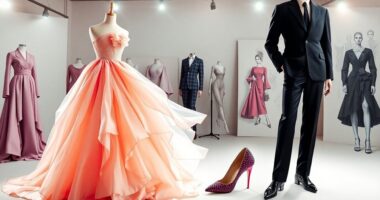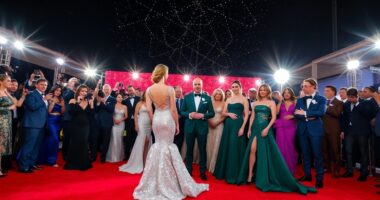Men’s fashion has evolved dramatically over the decades, from the understated elegance of Beau Brummell in the 18th century to the vibrant styles of the 1920s. Tailored suits gained prominence in the 19th century, while the early 20th century embraced practicality with three-piece suits. The bold prints of zoot suits in the mid-20th century reflected cultural shifts. Each decade brought unique trends that shaped men’s wardrobes. Keep exploring to uncover more fascinating details about these iconic fashion transformations.
Key Takeaways
- 18th Century fashion emphasized tailored suits and simplicity, moving away from opulence to a focus on understated elegance.
- The 19th Century introduced frock coats and formal dress codes, making black-tie attire a staple for sophisticated events.
- Early 20th Century trends featured tall silhouettes, stiff collars, and three-piece suits, reflecting a balance of practicality and formality.
- The 1920s brought vibrant styles with double-breasted suits, wider trousers, and accessories like feathered hats, marking a cultural shift.
- Mid to Late 20th Century fashion was influenced by jazz culture, featuring zoot suits, casual Hawaiian shirts, and tailored elegance from European designers.

Men’s fashion has evolved dramatically over the centuries, reflecting societal changes and cultural influences. In the 18th century, Beau Brummell revolutionized British fashion by advocating for understated elegance. You’d see men opting for tailored suits that emphasized simplicity rather than opulence. The tailcoat became a staple for formal occasions, while pantaloon trousers marked a shift from traditional breeches. The Anglomania movement saw British style influence Europe, promoting sober yet refined attire. Completing the look were polished boots and accessories that defined the gentleman’s ensemble.
As you move into the 19th century, the Industrial Revolution played a significant role in shaping men’s fashion. This era ushered in a more serious and sober style, with a strong emphasis on professional attire. Frock coats gained popularity as daytime wear, balancing elegance with functionality. The introduction of ready-made clothes made fashion accessible, allowing more men to express style without custom tailoring.
Formal events began to require specific dress codes, leading to the rise of black-tie attire. Top hats and canes became common accessories, adding a touch of sophistication to any outfit.
In the early 20th century, tall, lean silhouettes dominated men’s fashion. Stiff collars and three-piece suits emphasized a utilitarian style, while trousers with turn-ups became fashionable. You might find sack coats and vest suits as popular choices for formal occasions.
As the 1920s rolled in, the Roaring Twenties brought a vibrant cultural scene that influenced fashion. Double-breasted flannel suits became standard for formal events, while wider trousers aligned with broader styles of the era. Sport coats and plus-fours emerged as popular casual options, complemented by feathered hats and gloves.
The mid-20th century saw the rise of zoot suits and bold prints, reflecting cultural influences from jazz and wartime America. Trilby and homburg hats became fashionable for formal occasions, while casual wear like Hawaiian shirts gained traction.
Post-war, tailored suits symbolized elegance, with Italian and French fashion leaving a significant impact on men’s wardrobes.
Frequently Asked Questions
How Can I Incorporate Vintage Styles Into My Modern Wardrobe?
To incorporate vintage styles into your modern wardrobe, start small with accessories like scarves or sunglasses.
Mix vintage items with modern basics for a unique look, such as pairing a vintage dress with contemporary sneakers.
Consider tailoring vintage pieces for a better fit, and balance them with current styles.
Don’t hesitate to experiment with layering and accessorizing to create a fresh, stylish ensemble that reflects your personality while embracing timeless appeal.
What Are the Key Pieces for a Timeless Men’S Wardrobe?
Imagine opening your closet and finding every piece you need for any occasion.
To achieve that, you need key staples. Start with classic t-shirts and versatile button-down shirts.
Dark wash jeans and neutral chinos set the foundation.
Don’t forget stylish footwear like brown derbies and leather loafers.
A timeless outerwear piece, like a trench coat, completes the look.
With these essentials, you’ll always be ready for whatever life throws your way.
How Do Cultural Influences Shape Men’S Fashion Trends?
Cultural influences shape men’s fashion trends by blending traditional garments with modern styles.
You’ll notice how vibrant African patterns or elegant Asian textiles appear in contemporary collections, creating a unique fusion.
Historical events and pop culture icons also play a role, as they introduce new styles and concepts.
As globalization connects diverse cultures, you’re likely to see a mix of influences that reflect heritage while embracing current trends.
What Fashion Icons Have Significantly Impacted Men’S Styles Over the Decades?
Ever wondered who shaped the way you dress today? Iconic figures like Beau Brummell set the standard for elegance, while Steve McQueen brought rugged masculinity into the spotlight.
Oscar Wilde and David Bowie pushed boundaries with their flamboyant and androgynous styles, inspiring you to embrace creativity.
In recent years, stars like Harry Styles have blended comfort with boldness, showing you that personal expression is key in modern men’s fashion.
How Do I Choose Colors That Complement My Skin Tone in Fashion?
To choose colors that complement your skin tone, first identify your undertone: warm, cool, or neutral.
If you’ve got warm undertones, opt for earthy tones and warm neutrals. For cool undertones, look for jewel tones and pastels.
If you have dark skin, vibrant jewel tones and deep colors enhance your features.
Avoid colors that clash with your undertones, like pale pastels for warm skin or earthy tones for cool skin.
Conclusion
As you reflect on men’s fashion through the decades, picture the sharp suits of the 1960s contrasting with the relaxed grunge of the ’90s. You can see how each era tells a story, from the dapper elegance of the roaring ’20s to the carefree vibes of today. Fashion’s evolution is like a time capsule, revealing not just trends but the spirit of each generation. Embrace this journey and let your style be a blend of history and individuality.









